|
Green Cove Springs Marina,
Florida
1st November - 11th December
2006
|
|
Anju had looked after us well for yet another
year and it was time to pay her back with some serious
maintenance. We started with a job list a page long, which
quickly doubled and tripled in length. We worked six long
weeks, seven ten-hour-days each week to tend to our darling
Anju. Much of what we achieved was made considerably easier by
the help of the staff at Green Cove Springs, Paul, Tracy, Dave and
Crystal. Topside painting would have been impossible
without the generous loan of staging by "Bottom Dave".
Rob from Sandpiper became a regular chauffeur for Team Anju and offered much
moral support and the occasional cat-fix in the form of visits from his
ship's cat Sharkbait (Sharky). We commissioned the talents
of welder Harry Walden, originally from Norfolk in the UK, who attended to some of
Anju's more serious ailments.
|
|
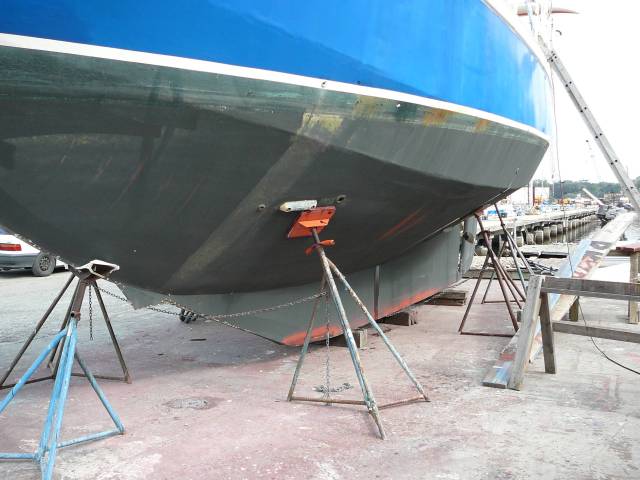
|
After hauling Anju out and eventually finding a
ladder so we could get back aboard, we inspected for any damage from our
recent grounding in Wrightsville Beach. Apart from the loss of
some of the black anti-fouling paint from the bottom of the keel, exposing
earlier red coats beneath, all seemed well. The rest of the day
was spent clearing the decks and lockers, unloading all the gear we stow on
deck; fenders, fishing nets, life-rings, gaffs, boat hooks, piles of ropes,
etc, etc, plus lowering all the anchors and the dinghy to ground
level. It really was amazing how much we carried down the ladder for
storage!
|
|
For over a year Anju's bowsprit, which had
undergone alteration by hacksaw, whilst at sea in Maine, when we'd realised
that the new roller furler wouldn't turn without rubbing on the rails, had
been left in that state, with duct tape covering the holes left in the
rails. We did use the up-market white variety of duct tape to
make it look pretty!. It was time to make a more permanent job
of the alteration and also to chip off 20 years of old paint, treat any rust
spots and then repaint from primer up to top coat. We had
complaints about the noise from our chipping hammers which went on for two
long days, driving not only our neighbours but ourselves a little
crazy. We became nicknamed the woodpeckers! Altogether the work
on the bowsprit took almost a week, it was amazing just how long a
"small" job could take but finally after several coats of primer,
including our new experiment of a chlorinated rubber primer, followed by
undercoat and two coats of top coat, the job was finished and the wooden
planking could be returned. It was time to get started on the
"big" jobs!
|
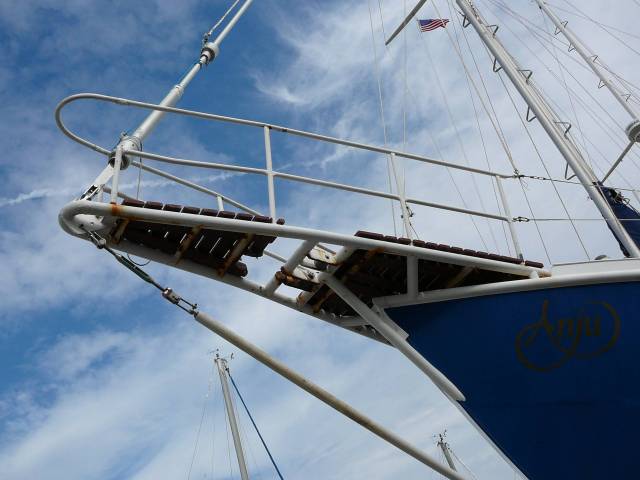
|
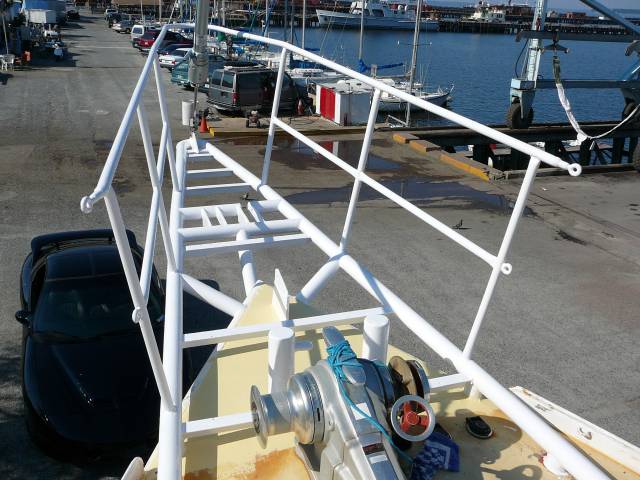
|
|
The bowsprit before and
after a week of hard work
|
|
Another job high on our priority list was to buy
and install some solar panels on Anju's arch at the stern. The
arch had been designed specifically to accommodate panels, to boost our
power generation aboard but until now, three years later, our budget hadn't
stretched to buying any. Before going ahead with the purchase of
a whole kit, including panels and a controller for around $1700 dollars, we
took a stroll along the dock at the marina to take a look at ways solar
panels had been mounted on other boats. As we walked we spotted
several panels lying by the side of a trailer parked on the dock and went
over to take a closer look at the back of the panels, to see how we would be
able to mount similar panels on our boat. It was then that we
met Cole, the owner of the panels which he'd salvaged from an old oil rig
which was being broken up.
|
|
Cole wondered if we wanted to buy the panels
from him as he had been planning to sell them. We came to an
arrangement favourable for all involved, which involved transfer of a small
amount of dollars and one rarely used, almost brand new 3.5 hp outboard
engine from Anju to Cole, in return for the four 55 watt solar
panels. There was just one snag, the panels were set up to
produce 24 volt electricity, not 12 volt, so Phil's next challenge was to
give himself and intensive training course in the wiring of solar
panels. Meanwhile Christine set to work on repairing any rust
spots on the arch and in only a couple of days Anju's new solar panels were
up and running on the newly refinished arch!
|
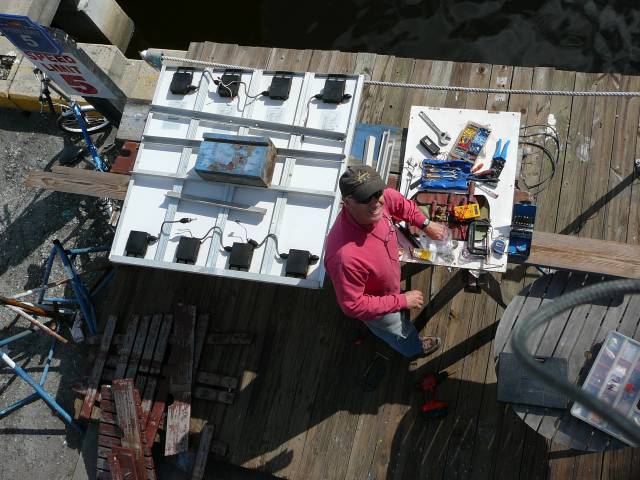
Solar panel wiring 101,
supervised from above.
|
|
Once the panels were safely mounted on the arch,
we had to set to work on the steel under the "cocktail deck" or
aft platform, which was looking decidedly shabby. All the planks
had to be taken up and the steel beneath given a dose of care with the angle
grinders, before it could all be repainted. Needless to say this
involved the crew perching precariously and uncomfortably on one inch wide
steel, high above the ground, whilst operating power tools. This
was followed by several rounds of painting, where much paint ended up in the
hair and up the arms of the painters! It was a great relief to
finally re-lay the planks. We also cut off the rusty boarding ladder
on the stern of the boat for replacement with a new stainless ladder made by
Harry, the welder.
|
|
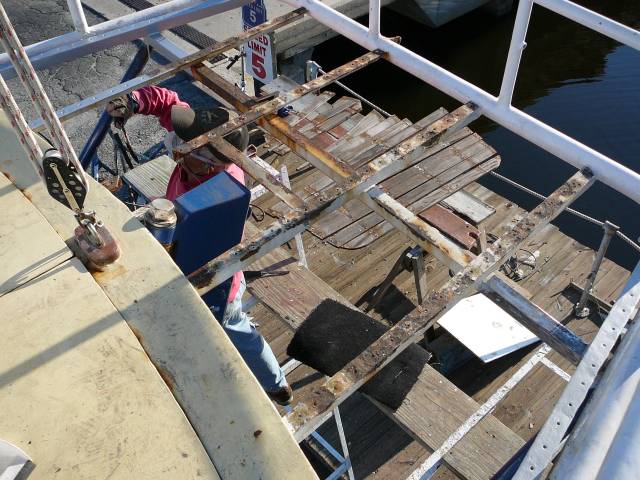
Tackling the rust hidden
beneath the "cocktail deck"
|
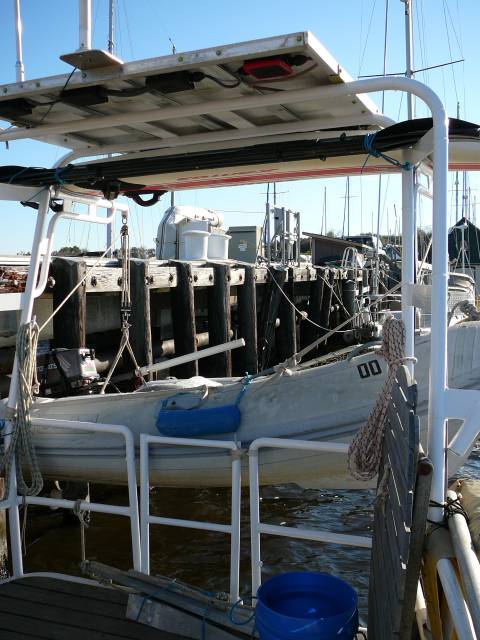
The finished result, solar
panels and new ladder in place.
|
|
A problem we had experienced on a continual
basis was the rusting of the chain plates, the steel eyes welded to the
deck, to which the wire rigging is connected. The pins on the
rigging were made of stainless steel and the chain plates of mild steel and
a combination of the constant moving of the rigging pins against the chain
plates when under sail and the mixture of two dissimilar metals had led to
some corrosion, which on further investigation turned out to be more serious
than we'd thought. It was time to set Harry to work again,
replacing the mild steel chain plates with stainless, which was welded to
the hull. Harry's work was excellent and the result was
not only a cosmetic improvement but also an essential and timely safety
improvement!
|
|
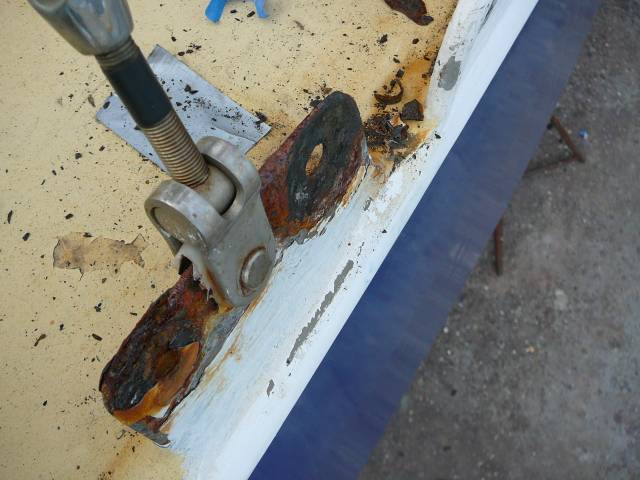
This was definitely an
"uh-oh" moment
|
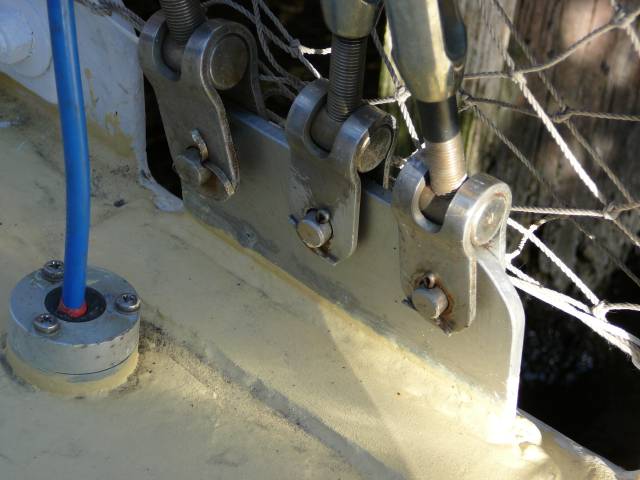
Harry's handiwork, a major
improvement!
|
|
Once the aft deck looked shiny and new, the
lazerette became the next eyesore for attention. The rudder was
disconnected from the hydraulic steering ram, which was also in need of some
tender loving care. Dealing with the rust in the lazerette
lockers was another really unpleasant task, hanging upside down with the
chipping hammers, angle grinders and the paint brushes. The only
way to reach the really difficult spots was to fold Christine up as small as
possible on her side inside the locker with a hammer in hand.
|
|
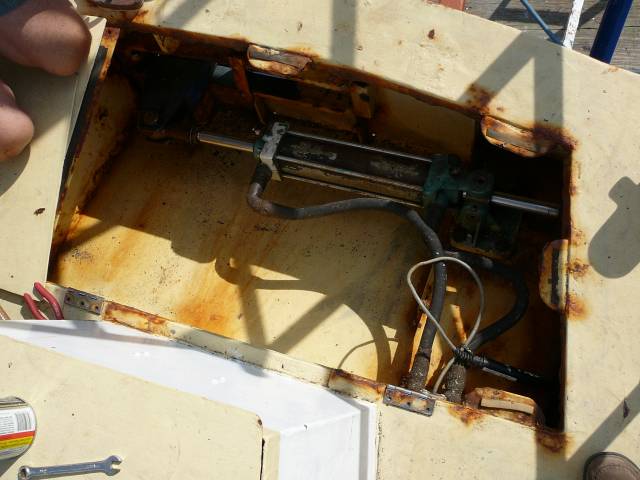
Before shot of the
lazerette and steering gear.........
|
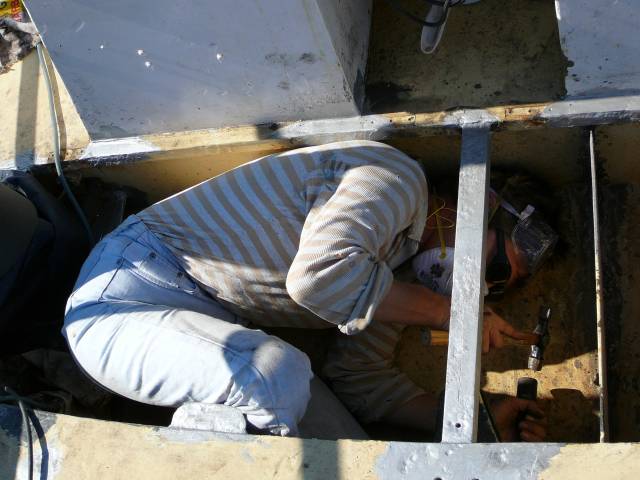
......which fits much more
comfortably than Christine!
|
|
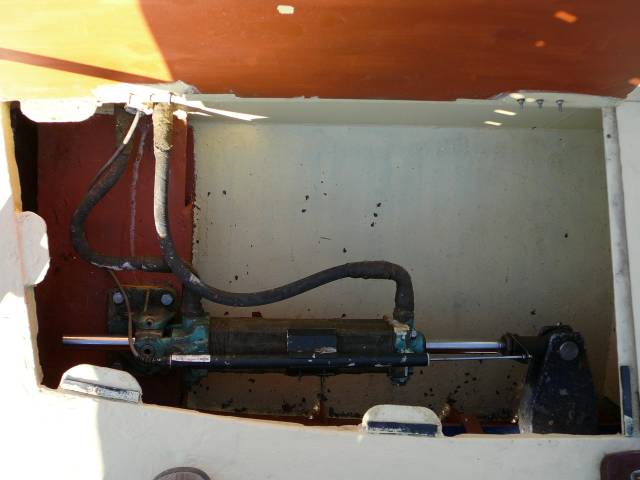
The finished result.
|
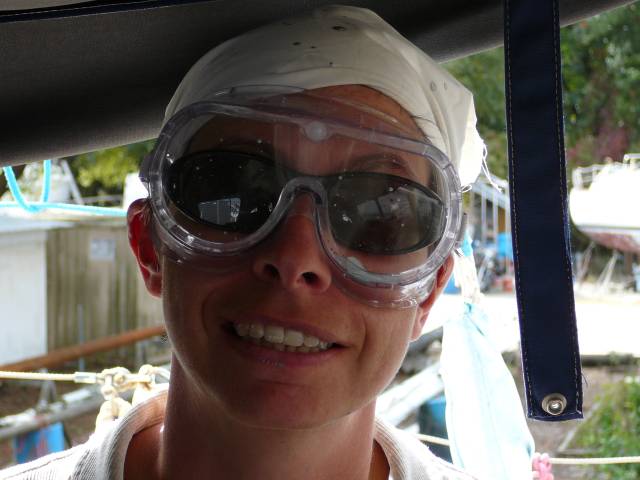
The glamour of the yachting
life!
|
|
Working on such time-consuming and awkward jobs,
which took days of work before finally being crossed off the job list, could
be quite demoralising. We decided to start on the big
jobs. Christine for some reason and much to the amazement of the
spectators on the porch at Green Cove Springs Marina, selected a freezing
cold day to chip off barnacles off the hull and rub down the anti-fouling
paint with scourers and cold water, ready for painting when the temperature
rose enough for the paint to dry. Despite everyone's
insistence that she must be freezing, dressed in thermals and several layers
of dry warm clothing, with waterproofs on top, Wellington boots, a woolly
hat and diving gloves, whilst undertaking such a strenuous task, was
actually warm work. Two days later, the boat had been treated to two
more coats of anti-fouling paint to keep the slime and barnacles at bay, or
at least that was the hope.
Warm weather was needed for repainting the
topsides, the blue part of the hull, and careful preparations had been made
in anticipation of a suitable break in the weather. The hull was
sanded and all rust spots and damage repaired and primed ready for
application of the top coat. Topsides painting was
actually quite enjoyable, working as a team together on the scaffolding,
Phil applying the paint by roller and Christine "tipping-off" with
a brush, to ensure no bubbles formed. Luckily the rain
held off, as did the dust and bugs and we were pleased with the
results. Only one small problem remained, the "Anju" logo
transfers we'd had since leaving the UK had gone off and were
unusable. Christine spent an afternoon perched on the staging,
re-creating the logo in white paint, which also kept the spectators
amused. It was a task which was tough on the backside and the
nerves and she was particularly un-amused when, three quarters of the way
through painting the second Anju logo, someone suggested she should get them
made in vinyl transfers! The results, however were pretty good
considering the lack of artistic skill and appropriate materials involved in
their creation!
|
|
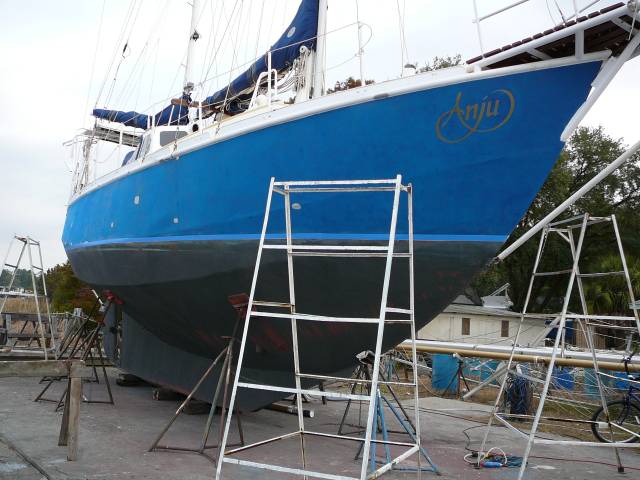
Topsides before...
|
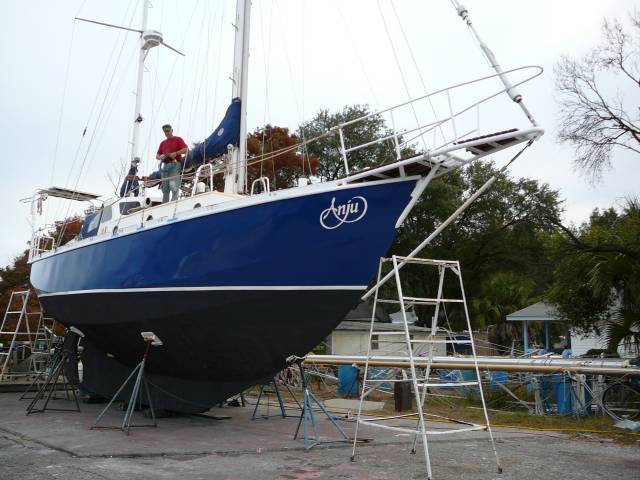
....and after.
|
|
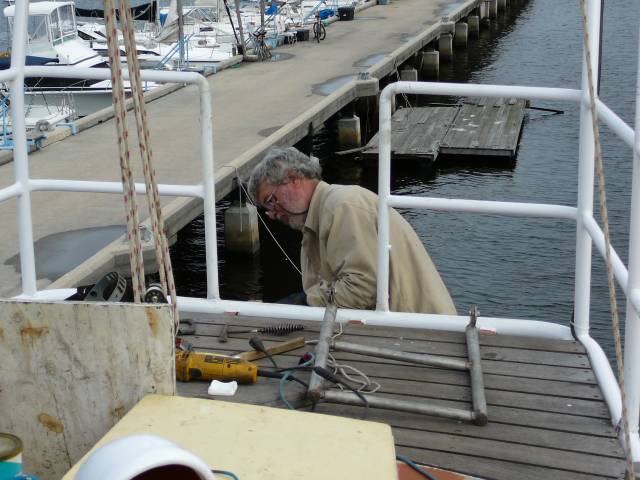
Harry at work on the stern
ladder.
|
Next job was repair and painting of the deck,
stanchions and white rub-rails, above the blue paint. Out came
the angle grinders again and preparations were made. Both Christine
and Phil discovered that angle grinding skin can be pretty painful, when
Christine ended up with a skinned knee and Phil with a skinned wrist -
ouch!
Before painting, we wanted to replace our
strange system of multiple genoa sheet tracks on each side of the deck with
one continuous track on each side. Phil began to remove the old
tracks, breaking about three impact driver bits in the process of removing
the old bolts. The bolt holes in the deck had to be repaired and
the deck filled and faired before painting. Trying to find track
to fit our existing genoa cars turned out to be trickier than you would have
expected but finally the new tracks were in place. Our plan was to
paint the deck just before leaving Anju for our visit to the UK, to allow
the paint to dry in peace without us walking up and down on it and we just
got finished in time.
|
|
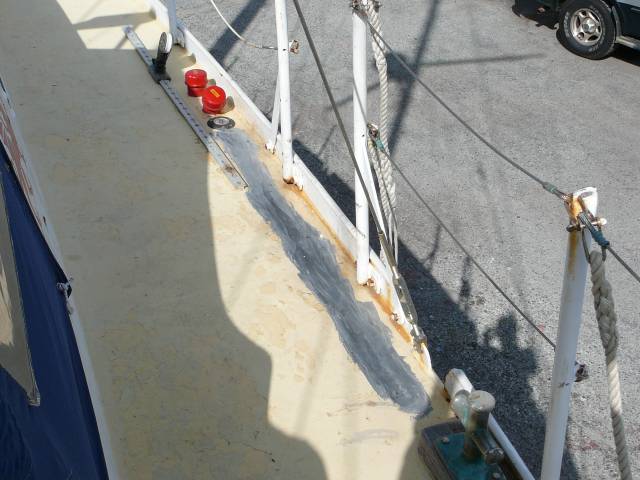
Old tracks removed and the
deck repainted
|
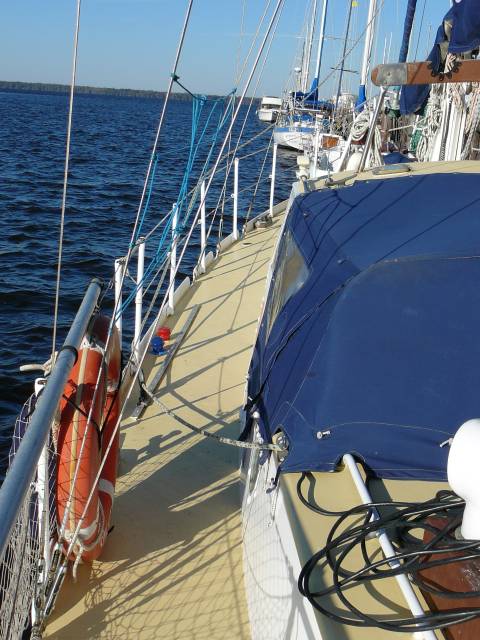
|
|
By the date we were due to fly to the UK, we'd
made good progress on the job list, although a few items remained for our
return, primarily re-siting the wind-generator up the mizzen mast as the
solar panels had now taken it's spot on the arch. To protect all
our hard work, we decided to pay a little more and leave Anju sitting safe
in the yard during our absence. We were exhausted and needed a
holiday, however that wasn't what fate had in store for us.....
|
















